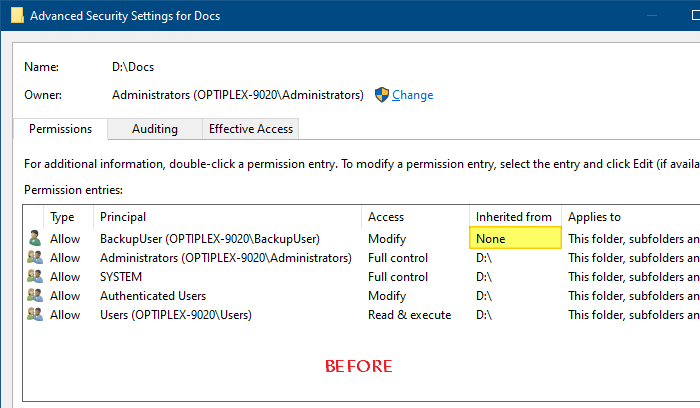

There are two types of permissions: explicit permissions and inherited permissions.Įxplicit permissions are those that are set by default on non-child objects when the object is created, or by user action on non-child, parent, or child objects. In short, there are two types of permissions - explicit permissions and inherited permissions.
WINDOWS 10 RESET PERMISSIONS HOW TO
How to take ownership and get full access to files and folders in Windows 10 Permission types If you are interested in managing NTFS permissions, refer to the following article: Also every object has an Owner which is the user account that can set ownership and change permissions. files can inherit permissions from their parent folder. It supports inheritance for an object, e.g.

Other user accounts are set to only read the files.Īs a user accesses each file, folder, registry key, printer, or an Active Directory object, the system checks its permissions. Ultimately, if you're unsure and the computer is at a point where you're about to format and reinstall anyways, then you probably don't have much to loose by resetting the permissions.Quickly Reset NTFS Permissions in Windows 10 Permissionsīy default, almost all system files, system folders and even Registry keys in Windows 10 are owned by a special built-in user account called "TrustedInstaller". I recommend checking the permissions in regedit while logged in as Administrator (or run regedit as Administrator) and comparing the permissions to another (known good) computer. By default, non-administrator accounts don't have access to write (and sometimes read) certain registry keys. Not every denied permission is a sign of corrupted registry permissions.

Your user account (or a group your account belongs to, such as Users) should have either Read, Write, or Full access to the key (depending on what it is.) Once you know what key(s) are unable to be read/written you can review the permissions by by running regedit, browse to the key(s), right-click on the key and select Permissions, then review the permissions that are listed. You can then use this information to review the permissions using regedit. ProcMon allows you to watch the execution of all programs (or a specific program) and see what registry keys and files are getting denied access. One utility that can help narrow down the keys that might be causing problems is ProcMon ( ). And a lot of the time they tend to only affect non-administrator accounts (although, if "read' permission has been stripped from every user/group, then the problem would also be present for administrators). Registry permission problems tend to create problems that are reproducible by a specific step every time. There is no easy way to describe this step. In our case we eventually narrowed it to down to a very old version of Crystal Reports that was corrupting the registry permissions, but only became an issue with Windows XP installation discs that were slip-streamed with SP2 and SP3 (see ) It's quite possible that other old applications could cause similar permissions issues. I have seen cases where registry permissions became corrupted by malware. There is always a root cause for those permissions becoming corrupted. I should mention that resetting your permissions is not something you should normally have to do. After having to reset permissions by hand a few times, I found a useful script that resets all the permissions with reasonable settings (as opposed to just giving Full Control to everyone, which is what most search results for "reset registry permissions" show you how to do.) But a few years ago at our office we started to notice EVERY computer was having weird issues (unable to run Adobe Flash, ODBC connections were only accessible by Administrators, certain features in MS Word and Excel wouldn't launch.) Eventually, thanks to the help of ProcMon, we determined it was registry permissions. Many times I chalked it up to "Windows being Windows" then formatted and reinstalled Windows.
WINDOWS 10 RESET PERMISSIONS SOFTWARE
Over the years I've had a handful of Windows installations that exhibited very weird software problems. *** I TAKE NO RESPONSIBILITY FOR ANY DAMAGE THAT MIGHT BE CAUSED BY FOLLOWING THESE STEPS OR USING THESE UTILITIES *** It is very easy to botch your Windows installation by accidentally wiping out all the permisisons (I've done it myself a few times.) Ensure you have backups before following any of these steps. WARNING: Take extreme precaution when using the RegEdit and SubInACL.


 0 kommentar(er)
0 kommentar(er)
